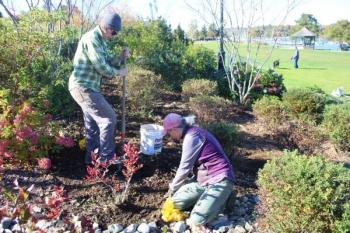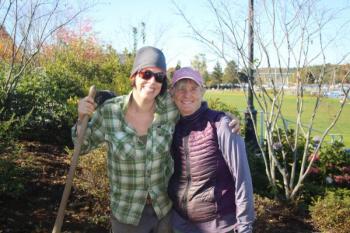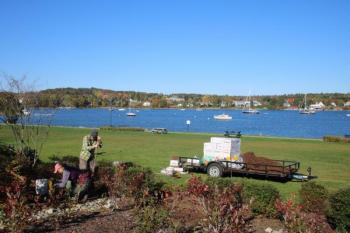Willing hands needed after 50,000 bulbs arrive in Belfast for Daffodil Project’s inaugural year
BELFAST — What was once an idea of Elisabeth Wolfe and her husband, Michael Cunningham, has become a reality after 50,000 daffodil bulbs were delivered to Belfast in early October. Two weeks later, Wolfe is still planting bulbs around the city.
After the initial 50,000 bulbs are planted, the plan is to continue planting 100,000 daffodils all around Belfast every year for 10 years, ultimately adding one million of the sunny-hued flowers to the area.
Anyone interested in volunteering can contact Elisabeth Wolfe at 338-4783 or simply show up at the Belfast Co-op this Saturday at noon.
Daffodils are one of the plant varieties that propagates via bulbs, which are typically planted in mid to late fall in New England. Although the term “bulb” includes a number of plants that have a swollen storage root or stem section which produces a flowering plant each year, some plants are true bulbs. Others that fall under the term propagate with tubers, corms, rhizomes, or bulbets.
Daffodils, which come in over 40 varieties, are true bulbs, as are lilies.
According to Gardening Know How (GKH), there are two types of bulbs in the true bulb category, including tunicate bulbs and imbricate bulbs.
Tunicate bulbs all have a papery outer skin that protects the interior scales, which are where food sources are stored. Tulips are a type of tunicate bulb.
Imbricate bulbs, which include lilies, do not have the papery covering and must remain moist prior to planting.
Though similar in appearance to true bulbs, corms are solid inside and include flowers like gladiolus, crocus, and freesia.
A tuber, on the other hand, is a swollen stem that has growth nodes, also known as “eyes.” Tubers, which include daylilies, are propagated by planting a piece of the tuber that contains several eyes. There are also tuberous roots, which are thickened roots that hold nutrition.
Rhizomes are underground stems that store plant food and are capable of sprouting new growth.
The last variety, bulbets, are “tiny round organs found growing on the tops of alliums and related plants,” according to GKH.
According to Roberta Bailey, who works for FedCo Seeds, and has written for the Maine Organic Farmers and Gardeners Association (MOFGA) for two decades, fall bulbs should be planted at least four to six weeks before the ground freezes. FedCo Seeds, which is located in Clinton, Maine, is the company Elisabeth Wolfe chose to supply bulbs for The Daffodil Project.
Since bulbs prefer full sun, one good option is to plant them under deciduous trees, as they will have the opportunity to grow in spring before leaves return to the trees. Location respective to the sun and other heat sources should also be considered since southern slopes warm earlier than those facing north, which promotes an earlier bloom.
Bailey also recommends ensuring that bulbs are planted in an area with proper drainage because bulbs generally don’t grow well or rot in poorly drained soil. She noted that some bulbs, such as crocus bulbs, can tolerate water far better than others.
There are two common approaches when it comes to planting fall bulbs. The first is to “naturalize,” which means planting the bulbs in individual holes spread amongst an existing garden or other desired area.
The second method is to simply prepare an open area. Bailey notes that mass plantings “make a greater impression than a few flowers,” and said that she aims to plant 10 of one type of bulb in a cluster.
Additional information from Bailey on planting with bulbs available here.
Erica Thoms can be reached at news@penbaypilot.com






























